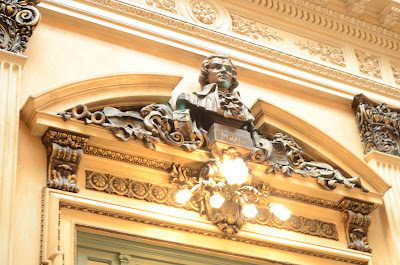Familia by Roman Vitali
and Esfera Azul (blue) by Julio Le Parc.
The Buenos Aires Metropolitan Cathedral is the burial site for General Jose de San Martin, the liberator of Argentina, Peru and Chile.
The previous day we discovered a Jewish Museum but could not enter because they require passports and photo ID. With the right documents in hand we returned. Sinagoga Libertad began with a chance meeting of two Jewish men praying in the Recoleta. They sought to find eight more for a minyan and then formed a congregation. Today there are about 180,000 Jews in Argentina, the largest Jewish population in Latin America. Sinagoga Libertad serves both Conservative and Reform members. Originally built in 1897 in the Moroccan style, it was expanded in 1923.
The synagogue houses the Museum of Judaica of Buenos Aires. This antique typewriter has Hebrew keys,
The collection includes a menorah made from shell casings,
a Sephardic torah cover
Seder plates,
an 1827 Megilla,
a 1782 Siddur,
and a Rabbi’s robe from 1935.
A temporary exhibit by Marcelo Toledo is a beautiful but painful memorial to the too many terrorist attacks against but not limited to Jews throughout the world.
The AMIA (Association Mutual Israelita Argentina) bombing in Buenos Aires,
the Twin Towers,
the synagogue in Pittsburgh,
and other terrorist acts against non Jews like the Manchaster bombing in England.Some comic relief in the synagogue. These stalls were a first for us. Not sure to laugh or be offended.
We ended our stay in BA by following the advice of one of our excellent tours guides. She told us to go to El Sanjuanino for empanadas. We could not resist wine served by a penguin.
A couple of empanadas and a shared salad barely left us room for that last taste of ice cream from Freddos.
We finally head for home thus ending this trip.
We look forward to picking up our travels next month in New York. Hope you enjoyed this experience with us.


















































